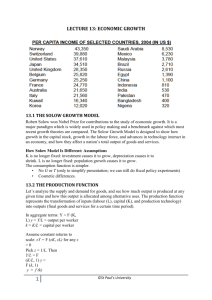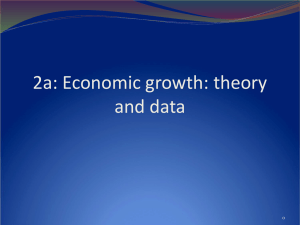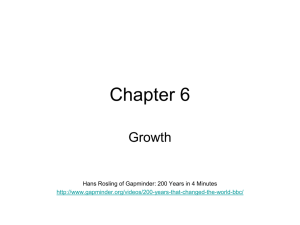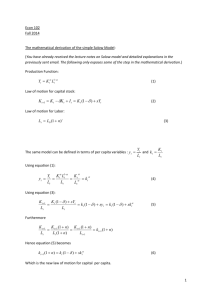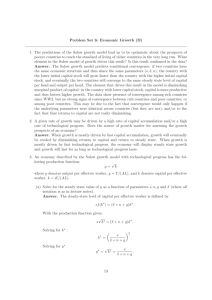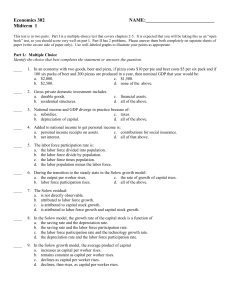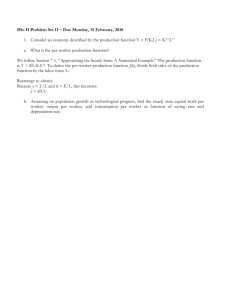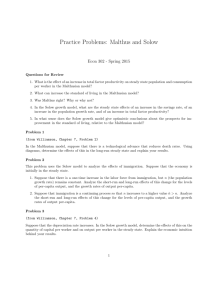Theory of Economic Growth
advertisement
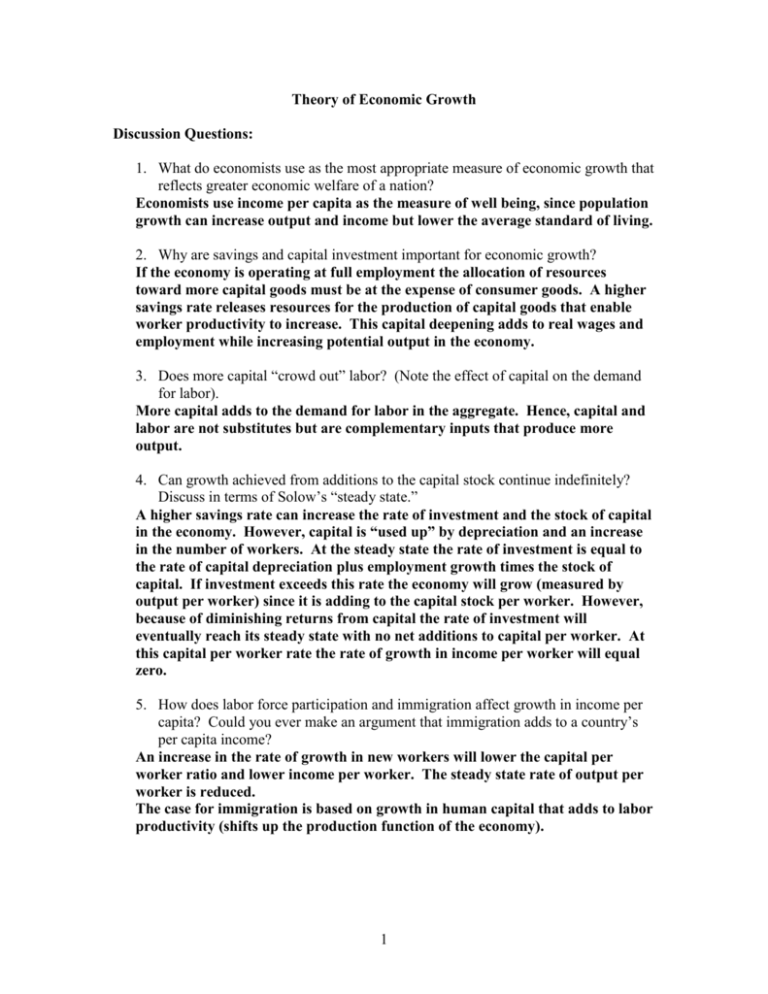
Theory of Economic Growth Discussion Questions: 1. What do economists use as the most appropriate measure of economic growth that reflects greater economic welfare of a nation? Economists use income per capita as the measure of well being, since population growth can increase output and income but lower the average standard of living. 2. Why are savings and capital investment important for economic growth? If the economy is operating at full employment the allocation of resources toward more capital goods must be at the expense of consumer goods. A higher savings rate releases resources for the production of capital goods that enable worker productivity to increase. This capital deepening adds to real wages and employment while increasing potential output in the economy. 3. Does more capital “crowd out” labor? (Note the effect of capital on the demand for labor). More capital adds to the demand for labor in the aggregate. Hence, capital and labor are not substitutes but are complementary inputs that produce more output. 4. Can growth achieved from additions to the capital stock continue indefinitely? Discuss in terms of Solow’s “steady state.” A higher savings rate can increase the rate of investment and the stock of capital in the economy. However, capital is “used up” by depreciation and an increase in the number of workers. At the steady state the rate of investment is equal to the rate of capital depreciation plus employment growth times the stock of capital. If investment exceeds this rate the economy will grow (measured by output per worker) since it is adding to the capital stock per worker. However, because of diminishing returns from capital the rate of investment will eventually reach its steady state with no net additions to capital per worker. At this capital per worker rate the rate of growth in income per worker will equal zero. 5. How does labor force participation and immigration affect growth in income per capita? Could you ever make an argument that immigration adds to a country’s per capita income? An increase in the rate of growth in new workers will lower the capital per worker ratio and lower income per worker. The steady state rate of output per worker is reduced. The case for immigration is based on growth in human capital that adds to labor productivity (shifts up the production function of the economy). 1 6. Solow’s neoclassical growth model predicts per capita income convergence among countries. Briefly describe in your own words why richer countries are getting richer and poorer countries are getting poorer (i.e. per capita income is diverging rather than converging). Solow’s growth model predicts convergence in income if each country operates on the same production function. Rich countries have higher production functions than poor countries. Labor resources are not homogenous, favoring rich countries with more educated workers. Educated workers can take advantage of more sophisticated technologies and encourage greater application of existing technologies and innovation of new technologies. Other conditions favoring rich countries are the openness to foreign trade, favorable geographic location, supportive political capita (less diversion and corruption), public infrastructure, and legal environments (like intellectual property rights) that favor technological transfer and development. 7. What is meant by the “Solow residual?” How does this relate to innovation and knowledge? The Solow residual is the percent change in output that is not explained by the percent change in capital or percent change in labor. This “total factor productivity” is exogenous in the Solow model and is based on the rate of change in A that depends on innovation and knowledge. 8. How does new (endogenous) growth theory explain that ability of growth to “feed on itself?” Endogenous growth theory assumes that ideas are developed into innovation without diminishing returns because the application of new ideas are nonrivalrous (I can apply the idea without diminishing you’re ability to apply the idea), provided market conditions are favorable. However, because the initial cost of new innovations are high and the marginal costs of copying the idea are virtually zero, imperfect competition, patents, and copyrights are important market conditions favoring risky innovative investment. With higher expected returns from innovation, new technologies will develop that provide the basis for higher income growth and more favorable education environments that build into the future. 9. Explain why productivity growth declined from 1973-95 and increased from 1995-2002. The so-called Great Slowdown between 1973-95 occurred because of several potential reasons, including the following: measurement errors in a service economy that undervalued output, higher oil prices, slowing growth in human capital (partly due to demographics of younger workers with less experience), government regulation (may be beneficial for other uses but not for higher income per capita), higher inflation that caused investors to be more “present” oriented, and the running out of ideas argument that contributed to a lag in new technology. 2 Problem Consider an economy characterized by a Cobb-Douglas production function as follows: Y = A K0.25 N0.75 where A = 4. The savings rate of the economy, s = 0.1. The population growth rate of the economy, n = 0.025, the depreciation rate of capital is 0.075, and the growth rate of autonomous factors is zero. 1. Convert the production function to a function relating Y/N to K/N. Divide both sides of the equation above by N results in the following equation: (Use y to represent Y/N and k to represent K/N, but don’t confuse with y that the author uses for the rate of growth in output and k that the author uses for the rate of growth in capital.) y = A k 0.25 2. Find the steady-state capital-labor ratio. The steady state k*occurs when the rate of investment, s y = (n + d) k Solving: 0.1 y or .1*A k*.025 = (.025 + .075) k* or .1 (4) k*.025 = .1 k* by dividing both sides of the equation by .1k*.025 we have the following: k*0.75 = 4 or k* ¾ = 4 Raise both sides of the equation to the power of 4/3 then k* = 4 4/3 or k* = 6.35 3. Find the steady-state output per person, y* Solving for output per worker as a function of A and capital per worker y* = A k* .25 = 4 (6.32) .25 = 6.35 4. Suppose two countries have the same production function as above, have access to the same technology, and have the same quality of labor and capital. But, suppose one country has output per person that is 2 times higher than the other country. To what factor is the difference attributable? The difference between the two countries can be due to a higher rate of savings in one country versus the other for the same values of A and b. Suppose, for example, that the savings rate increased to 0.2 for one country but remained at 0.1 for the other. Then in the example above, the steady state capital per worker, k* would be equal to 8 4/3 rather than 4 4/3 or 15.89 rather than 6.35. Steady state output per worker, y*, would be 4(15.89) .25 or 7.99 rather than 6.35. A similar difference would occur if the richer country had a lower rate of population growth or rate of capital depreciation (n + d). It might also be possible that access to technology does not insure the same rate of application. If A were higher in one country than another, then it would experience greater output per worker at the same rate of capital per worker. 3
